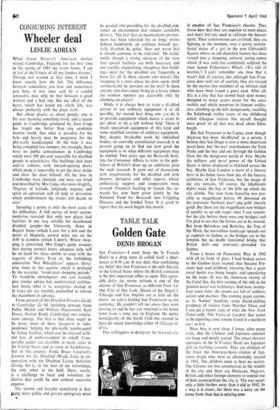Wheeler deal
CONSUMING INTEREST LESLIE ADRIAN
When Gwen Raverat's American mother visited Cambridge, England, for the first time in the spring of 1883 she wrote home, 'I am at last at the Utopia of all my fondest dreams.' Though not around at that time, I think I know exactly how she felt. The difference between somewhere you love and somewhere you hate, it was once said by a candid sensualist, may only be that between a good woman and a bad one. But my affair of the heart, which has lasted my whole life, was always primarily with the place itself.
But about places, as about people, one is for ever learning something fresh; and a recent guide to Cambridge produced by Joan Copp has taught me, better than any academic treatise could, that what is paradise for the hale and hearty may be purgatory for the physically handicapped. At the time it was being compiled last summer, for example, there were no public conveniences in Cambridge which were 100 per cent accessible for disabled people in wheelchairs. The buildings had steps and/or cubicles with inward-opening doors which made it impossible to get the chair inside and close the door behind. All the loos in Cambridge were checked, and most are listed and described by Mrs Copp, who notes brightly, 'Degrees of latitude, longitude, urgency and spirit of adventure will all help to determine which establishment the reader will decide to visit.'
Spending a penny is only the most acute of the difficulties. A full survey of hotel accom- modation revealed that only two places had facilities in any way suitable for chairbound disabled people—the University Arms in Regent Street (which I care for a lot) and the motel at Shepreth, several miles out on the A10 to London (which I don't). Where shop- ping is concerned, Mrs Copp's guide assumes that during normal hours adequate help will be on hand for those unable to cope with the vagaries of doors. Even so, the forbidding annotation 'Not Wheelchairs' appears thirty- nine times in this section, which is prefaced by the warning: 'avoid peak shopping periods.'
To would-be churchgoers one can scarcely give similar advice but, ecclesiastical architec- ture being what it is, categories exalted in St Luke xiv are sensibly counselled to inform the incumbent in advance.
From perusal of this Disabled Person's Guide to Cambridge (2s 6d, including postage, from Public Health and Welfare Department, Kett House, Station Road, Cambridge) two conclu- sions emerge. The first is that there ought to be many more of these 'passports to inde- pendence,' helping the physically handicapped by listing facilities which can be enjoyed with- out fear of embarrassment or rebuff. Com- parable guides are available to many cities in the United States' and to some in Scandinavia. But in this country Freda Bruce Lockhart's London for the Disabled (Ward, Lock in co- operation with the Disabled Living Activities Group, 6s) is, to the best of my knowledge, the only other in the field. Here, surely, is a challenge to local and voluntary in- itiative that could be met without excessive expense.
The second and broader conclusion is that many more public and private enterprises must I- be goaded into providing for the disabled con- sumer an environment that reduces avoidable distress. 'The fact that an inconvenient environ- ment has been tolerated for so long,' writes Selwyn Goldsmith, an architect himself par- tially disabled by polio, 'does not mean that it should continue to be tolerated.' Mr Gold- smith, though a strong advocate of the view that special facilities are both necessary and not socially stigmatising, recognises that build- ings ideal for the disabled are frequently a boon for all. Is there anyone who doesn't like shopping in a store where the door opens itself automatically by pressure on the mat? Is there anyone who does enjoy living in a house where the window openers are accessible only by climbing on chairs?
While it is always best to train a disabled person to use ordinary equipment if at all possible, the second best thing one can do is to provide equipment which makes it easier to get about or do a job without help. There is much specialised equipment of this kind and some modified versions of ordinary equipment. But, despite invaluable work by individual bodies, no centrally coordinated research is at present going on to find out how good the equipment is or what different equipment may be needed. Two years ago the Research Insti- tute for Consumer Affairs (a sister to the pub- lishers of Which?) drew up an ambitious plan for such research. It grew out of discussions with organisations for the disabled and with doctors, therapists and other experts, whose enthusiastic support and cooperation were assured. Financial backing to launch this re- search has now been given jointly by the National Fund for Research into Crippling Diseases and the Sembal Trust. It is good to report that the work begins this month.














































 Previous page
Previous page